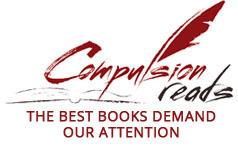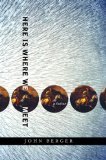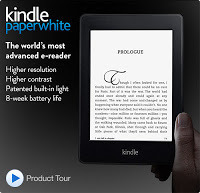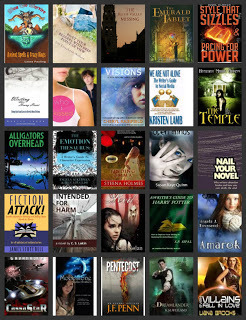Angela Ackerman's Blog: Writers Helping Writers, page 168
February 16, 2013
Physical Attributes Entry: Toes

Courtesy of DaniJace @ WANA Commons
Physical description of a character can be difficult to convey—too much will slow the pace or feel 'list-like', while too little will not allow readers to form a clear mental image. If a reader cannot imagine what your character looks like, they may have trouble connecting with them on a personal level, or caring about their plight.
One way to balance the showing and telling of physical description is to showcase a few details that really help 'tell the story' about who your character is and what they've been through up to this point. Think about what makes them different and interesting. Can a unique feature, clothing choice or way they carry themselves help to hint at their personality? Also, consider how they move their body. Using movement will naturally show a character's physical characteristics, keep the pace flowing and help to convey their emotions.
TOES
Descriptors: hairy, wrinkly, gnarled, bunioned, calloused, knobby, long, dirty, dainty, blistered, arthritic, rough, soft, stubby, broken, dry, bruised, frostbitten, webbed, pruned
Interesting Toe Factoids:
The length of the second toe (whether it’s longer than the other toes or shorter) is determined by genetics.
You can’t serve in the U.S. Army if you’re missing any toes. This led to drastic measures for some who wanted to avoid being drafted into the Vietnam War.
Syndactyly is a condition wherein two digits are fused or webbed. Famous individuals suffering from syndactyly of the toes include Ashton Kutcher, Dan Aykroyd, and Joseph Stalin.
Marilyn Monroe had six toes on one foot.
the first known prosthetic limb replacement was for an Egyptian woman’s big toe, in 1000 B.C)
Toe cramps are painful and inconvenient, particularly at 3 in the morning. (Yes, I speak from personal experience). I'm sure they could drop a grown man to his knees, which could be an interesting flaw for a manly hero-type character.
Key Emotions and Related Toe Gestures:
When someone is nervous or uncomfortable, toes can fidget or twitch like any other extremity. Adrenaline can cause the toes to tingle. And raucous, bladder-convulsing laughter can occur when the toes are tickled.
Simile and Metaphor Help:
Winter is not good for my toes. They dry out and get chalky and resemble aging mushrooms. It’s not pretty.
I hadn’t realized I’d been in the pool so long. My toes looked like shrunken walnuts.
Clichés to Avoid: toes that “curl” when someone is appalled or disgusted; the kiss that one feels all the way down to one’s toes; toes that are gnarled like tree roots
HINT: When describing any part of the body, try to use cues that show the reader more than just a physical description. Make your descriptions do double duty. Example: His toes were slender and snakeish, like fingers, the long one curving way out past the rest. Between them and the fossilized nails, I shuddered to think of the damage he could do with just his toes.
BONUS TIP: The Colors, Textures & Shapes Thesaurus in our sidebar might help you find a fresh take on some of the descriptors listed above!

Published on February 16, 2013 00:00
February 13, 2013
Writing Authentic Emotion Podcast

CP Storm
Happy Valentine's Day, everyone! I know, some people don't care for the commercialism of this holiday, but I say BAH! Let's just celebrate the love, both towards others, and ourselves. I know life gets hectic and we don't always make time for the little things that make us happy, so make me a promise that you'll do something nice for yourself today, all right? Treat yourself. Take a glass of wine and go for a soak in the tub. Eat some chocolate. Have some ME time!
Also, I'd like to link to a podcast I did recently with Gray Jones, the creator of TV Writer Podcast, a partner of Script Magazine. When Gray first contacted me about doing a podcast, I was blown away. After all, Gray has done all these great interviews with the writers of TV shows like Criminal Minds, ER, Law & Order, CSI, etc. and so many other amazingly talented people, I half-wondered if maybe his email landed in my inbox by mistake. But no, Gray had picked up a copy of The Emotion Thesaurus , and was struck by how well it would work as a resource for screenwriters. So, we had a great chat, and he asked me all kinds of good questions about writing techniques for conveying emotion, so if you're interested, have a watch/listen!
And just a reminder about three things coming up!
Indie Recon starts on the 19th of February, and it's free & online! This is a great conference for writers who are interested in Self Publishing. There's lots of great speakers, amazing advice on how to be successful as an Indie & making sure your book creates an impact in the marketplace.
WANA Con starts on the 22nd of February, and it's online as well! This conference has a small fee, but it is P-A-C-K-E-D with value! Here's the full schedule of events. If you've ever wanted the professional conference experience, but couldn't afford the costs, then this is a great event to attend!
Finally, our WEBINAR, Using Nonverbal Communication to Wow Readers is open for Registration. The webinar will be 90 minutes long and held on March 6th at 8:00 Eastern. This course includes a ecopy of The Emotion Thesaurus, too! And if you already have one, don't worry. We'll gift your copy to a writer friend of yours if you like. Seats are limited, so reserve yours ASAP!

Published on February 13, 2013 22:17
February 11, 2013
Dumping The Info Dumps
The Dreaded Info Dump. Did you wince a little as I wrote that? I know I did. That's because the info dump is something very easy to do, because after all, it's a great way to explain to readers why they should care about our characters, right? Well...not so much. It's actually something we should all avoid as much as possible, so please read on as our guest Leslie Ramey, Co-Founder of Compulsion Reads, dishes the real deal on INFO DUMPS.
Pssst! Afterward, please swing by Angela's World Of Writing (yes, another Angela! We are taking over the world, bwahahahaaa!) where she's sharing my post on Dealing With Rejection.
Dump the Info Dumps

One of the biggest challenges for writers is how to give readers the important backstory of their book without dropping a huge pile of information on them. As the co-founder of Compulsion Reads, a company that evaluates and endorses indie books, I’ve read my fair share of up-and-coming indie authors and have found that info dumps are a very common problem. (Being a writer, I too catch myself falling into the info dump trap)
The big issue with info dumps is that they stop the story dead in the water. The important thing to remember is that readers are smarter than we often give them credit for. They don’t need to know right now that your protagonist, let’s call her Jane, got stood up at prom in order to understand that she is having a hard time accepting that Hottie McNaughty wants to take her on a date. If you set up the scene well we should be able to see and feel her apprehension without having to read about that dreadful night at prom. By merely hinting at Jane’s painful past, you can create tension that helps keep the reader engaged.
The other problem that info dumps cause is that it’s nearly impossible to “show” an info dump. They almost always end up being “tells”, which affects a reader’s ability to fully immerse themself in your prose. When you stop to tell us why Hottie McNaughty doesn’t date drop dead beautiful women anymore we get pulled from all the emotions he feels when asking out Jane, and that’s a bummer. It would be like the power going out just as you were getting to the big scene of your favorite movie. Sure, the power will come back on and you can restart the DVD, but the moment has passed, and it’s just not the same.
So, how do authors avoid info dumps? Here are a few helpful tips so you can dump those info dumps:
1. Ask the question “Is this information critical to the scene”- Most of the time the answer will be ‘no,’ in which case you can limit how much information you are passing on. The reader doesn’t need to know right now that Jane’s mom belittled her, which is another reason she is skeptical of Hottie’s invitation. We should have already gotten the hint in the way that Jane acts, the way she dresses and through dialogue with her friends.
2. Sprinkle the information throughout the book- Instead of giving us all of the details right out of the gate, give us little bits here and there. Not only will this allow you to avoid overloading us with information, but we can slowly get to know your characters and the world you’ve created. In our example of Jane, you could have her in a dress shop with her BFF when she sees a row of prom dresses and shudders. She can then convince herself not to think about that horrible night. We readers know that we are going to find out what happened and are on pins and needles to read the big reveal later.
3. Let your characters hash it out- This tip can be very helpful and can go very badly, so keep your creative beast on a short leash when you try this technique. Have your characters discuss their backstories in believable situations. While Jane is in the store staring at the prom dress have her BFF remind her that not all men are like the loser who stood her up on prom night. Jane’s BFF could even go so far as to drop a line about how Jane’s mom was wrong, and that she really is a beautiful girl who any guy would be lucky to date. Look at that, not only did we reveal two big backstory moments in what could have been 100 words, but we also get to see Jane’s reactions to her BFF, letting us connect to Jane even more. The trick behind this tip is not to go overboard. Remember, readers are smart, and if you are using dialogue to retell a backstory we will know it and stick our tongues out at you for torturing us.
I know how hard it can be to avoid overloading your readers with information, but remember readers are smart, so don’t insult them. Instead, pull those info dumps, sprinkle your backstory throughout the book, and create a stronger, richer story that will fully immerse readers.
****

Compulsion Reads, created by Jessica Bennett and Leslie Ramey, seeks to shine the spotlight on quality indie books by endorsing those books that meet CR’s strict quality standards. Learn more about Compulsion Reads by visiting www.Compulsionreads.com. Enjoy our kooky video, read about our endorsement criteria and visit our growing library of endorsed indie books. You can also find us on Facebook and Twitter.
I think this is great advice, and I agree that it can be a large problem in novels, especially in those opening chapters as we try very hard to make the reader understand who our character is and why. A big thank you to Leslie for coming by to share a lesson gleaned from reading many, MANY books!
How about you, Musers? Do you have any other techniques to deal with bringing out critical information WITHOUT resorting to the big, pace-stopping info dump? This is a big struggle for so many of us, so please share!

Pssst! Afterward, please swing by Angela's World Of Writing (yes, another Angela! We are taking over the world, bwahahahaaa!) where she's sharing my post on Dealing With Rejection.
Dump the Info Dumps

One of the biggest challenges for writers is how to give readers the important backstory of their book without dropping a huge pile of information on them. As the co-founder of Compulsion Reads, a company that evaluates and endorses indie books, I’ve read my fair share of up-and-coming indie authors and have found that info dumps are a very common problem. (Being a writer, I too catch myself falling into the info dump trap)
The big issue with info dumps is that they stop the story dead in the water. The important thing to remember is that readers are smarter than we often give them credit for. They don’t need to know right now that your protagonist, let’s call her Jane, got stood up at prom in order to understand that she is having a hard time accepting that Hottie McNaughty wants to take her on a date. If you set up the scene well we should be able to see and feel her apprehension without having to read about that dreadful night at prom. By merely hinting at Jane’s painful past, you can create tension that helps keep the reader engaged.
The other problem that info dumps cause is that it’s nearly impossible to “show” an info dump. They almost always end up being “tells”, which affects a reader’s ability to fully immerse themself in your prose. When you stop to tell us why Hottie McNaughty doesn’t date drop dead beautiful women anymore we get pulled from all the emotions he feels when asking out Jane, and that’s a bummer. It would be like the power going out just as you were getting to the big scene of your favorite movie. Sure, the power will come back on and you can restart the DVD, but the moment has passed, and it’s just not the same.
So, how do authors avoid info dumps? Here are a few helpful tips so you can dump those info dumps:
1. Ask the question “Is this information critical to the scene”- Most of the time the answer will be ‘no,’ in which case you can limit how much information you are passing on. The reader doesn’t need to know right now that Jane’s mom belittled her, which is another reason she is skeptical of Hottie’s invitation. We should have already gotten the hint in the way that Jane acts, the way she dresses and through dialogue with her friends.
2. Sprinkle the information throughout the book- Instead of giving us all of the details right out of the gate, give us little bits here and there. Not only will this allow you to avoid overloading us with information, but we can slowly get to know your characters and the world you’ve created. In our example of Jane, you could have her in a dress shop with her BFF when she sees a row of prom dresses and shudders. She can then convince herself not to think about that horrible night. We readers know that we are going to find out what happened and are on pins and needles to read the big reveal later.
3. Let your characters hash it out- This tip can be very helpful and can go very badly, so keep your creative beast on a short leash when you try this technique. Have your characters discuss their backstories in believable situations. While Jane is in the store staring at the prom dress have her BFF remind her that not all men are like the loser who stood her up on prom night. Jane’s BFF could even go so far as to drop a line about how Jane’s mom was wrong, and that she really is a beautiful girl who any guy would be lucky to date. Look at that, not only did we reveal two big backstory moments in what could have been 100 words, but we also get to see Jane’s reactions to her BFF, letting us connect to Jane even more. The trick behind this tip is not to go overboard. Remember, readers are smart, and if you are using dialogue to retell a backstory we will know it and stick our tongues out at you for torturing us.
I know how hard it can be to avoid overloading your readers with information, but remember readers are smart, so don’t insult them. Instead, pull those info dumps, sprinkle your backstory throughout the book, and create a stronger, richer story that will fully immerse readers.
****

Compulsion Reads, created by Jessica Bennett and Leslie Ramey, seeks to shine the spotlight on quality indie books by endorsing those books that meet CR’s strict quality standards. Learn more about Compulsion Reads by visiting www.Compulsionreads.com. Enjoy our kooky video, read about our endorsement criteria and visit our growing library of endorsed indie books. You can also find us on Facebook and Twitter.
I think this is great advice, and I agree that it can be a large problem in novels, especially in those opening chapters as we try very hard to make the reader understand who our character is and why. A big thank you to Leslie for coming by to share a lesson gleaned from reading many, MANY books!
How about you, Musers? Do you have any other techniques to deal with bringing out critical information WITHOUT resorting to the big, pace-stopping info dump? This is a big struggle for so many of us, so please share!

Published on February 11, 2013 03:30
February 9, 2013
Physical Attributes Entry: Stomach

By Luca Boldrini
Physical description of a character can be difficult to convey—too much will slow the pace or feel 'list-like', while too little will not allow readers to form a clear mental image. If a reader cannot imagine what your character looks like, they may have trouble connecting with them on a personal level, or caring about their plight.
One way to balance the showing and telling of physical description is to showcase a few details that really help 'tell the story' about who your character is and what they've been through up to this point. Think about what makes them different and interesting. Can a unique feature, clothing choice or way they carry themselves help to hint at their personality? Also, consider how they move their body. Using movement will naturally show a character's physical characteristics, keep the pace flowing and help to convey their emotions.
Stomach
(AKA: belly, midsection, tummy, breadbasket, gut, midriff, etc.)
Descriptors : flat, tight, pierced, round, thick, jiggly, bloated, puffy, stretch marked, bloblike, rolly, ballooned, pregnant, hefty, plump, obese, pudgy, portly, skinny, taut, slim, smooth, bumpy, tattooed, hairy, veined, sculpted, pouched, swollen, soft, hard, flabby, tanned, pale, brown, firm, loose
Things Stomachs Do:
Bounce: jiggle, vibrate, quiver, tremble, shake, judder, jounce
Tighten: harden, tense, suck in, bind
Slacken: release, bulge, balloon, billow, relax, stretch
Key Emotions and Related Stomach Gestures:
Embarrassment: When people are self conscious and especially if they are embarrassed of their body image, it is common to suck in the stomach to make it appear flatter, or to use arms to hide the stomach by crossing them. People who are confident in their shape have no qualms about dressing so their midriff is exposed or clearly shape through revealing/tight clothing, while those who with less confidence dress to conceal this area.
Shock or Surprise: When someone is startled it is common for all the muscles to tense up, including the stomach. Once the moment passes, muscles are allowed to go flaccid once more. Laughter (in the aftermath of a good surprise) will cause the belly to shake.
Simile and Metaphor Help:
The man snored on his narrow beach towel, his massive, sun-burned gut looking like a giant zit ready to pop.
On the boardwalk, Sheila bopped in time to the music, oblivious to the doughy spillover happening at the top of her too-tight jean shorts.
Clichés to Avoid : likening someone a beached whale; fat jokes that ask where Ahab is; the beer keg or barrel stomach; making comparisons to Jabba the Hutt or the Pillsbury dough boy
HINT: When describing any part of the body, try to use cues that show the reader more than just a physical description. Make your descriptions do double duty. Example:
I loved watching Eric sleep--so quiet and composed, his small chest rising and falling in a pattern, his stomach smooth and flat. His stillness was so unlike him when awake. Then, he became a wild, electrified force that bounced all over the house. But while he napped, I had him all to myself, watching to see if he would smile, if his belly would shake with silent laughter at something only a three-year-old would dream.
BONUS TIP: The Colors, Textures & Shapes Thesaurus in our sidebar might help you find a fresh take on some of the descriptors listed above!

Published on February 09, 2013 10:23
February 6, 2013
A New Addition To The Bookshelf Muse

photo by stirwise/flickr
This post is a bit of a mish-mash, but there's some exciting things going on that might just be BIGGER THAN BACON.
WEBINARS!
First, you may have noticed a NEW Page tab above labelled Workshops and Webinars. Becca and I are happy to announce that we're taking our show on the Virtual Road, and doing a bit of teaching!
Our first webinar, on March 6th, is Using Nonverbal Communication To Wow Readers and is being hosted by WANA International. If you struggle with emotion and how to show it, this is the class for you. Wana also has many other courses for creatives, too! We hope to see some of you there. :)

GRATITUDE!
Becca and I have chosen our Charity of the Year and want to introduce it to all of you! Last year, we picked Heifer International, and thanks to your support, we were able to donate a portion of our royalties to this worthy cause. This year we're choosing UEND: Poverty, a organization that has projects all over the globe to help wipe out poverty. I found out about this charity a few years ago when my husband gave me a gift certificate for it for my birthday, and I was able to go into the site and choose which project to put the money toward. Very cool stuff!

CONFERENCE!
Circling back to WANA International, we're also very excited to share their first online conference coming on Feb 22 & 23. The line up of speakers is amazing.There will be Agent Pitching and great advice from some of the best in the biz. And of course no event would be complete without some social fun, so there's a mixer and pajama party, too! You can download the full conference schedule right here.
GUEST POST!
Also, Becca is over at one of the most amazing blogs on the internet: Query Tracker,
so please feel free to stop in and say hello! This blog and site was so
helpful when I was looking for my agent--I hope any of you on the hunt
are checking into all the information and tools they have for writers.
COMMUNITY!
Finally, when we were celebrating our 3 BIG January milestones with a Kindle Giveaway, I asked to hear about the blogs that have helped you recently. You guys had so many sites to share, rather than let those blogs get lost in the comments, I rounded up all the ones you left links for and posted them below. Blogging and writing is also about building community, so I urge you to choose a blog on the list that you don't yet know and take a minute to swing by and say hello!
Blogs valued By Musers 2013
Krista Von Dolzer
Enriching Lives. Inspiring Hope
Rose Anne McCauley
Female First
Nail Your Novel
Janice Gable Bashman
Literary Rambles
Falling Leaflets
Cock-eyed Caravan
Lisa L. Regan
Nancy S. Thompson
Jami Gold
K.M. Weiland
Coffeehouse For Writers
Slushpile Hell
Conversations With Writers
GenXposé
Theresa's Tales of Teaching Tribulations and Typing Teen Texts
Catherine Scully
Rose Gaus: The Draw Page
Sparknotes
The Quintessentially Questionable Query Experiment
dVerse Poet's Pub
Studio Mothers
James Scott Bell
Writer Unboxed
Magical Words
Vaughn Roycroft
Jody Helund
Sarah Nego
Kristal Shaff
Janice Hardy
Juliana Brandt
The Write Practice
Dean Wesley Smith
Kristine Kathryn Rusch
Ellie Garratt
Gwen Gardner
Back Porch Reflections
Stacy Nash
Elana Johnson
Self Publishing Podcast
The Creative Pen
A Thought Grows
Live Write Thrive
Julie Coulter Bellon
Terrible Minds
Marcy Kennedy
The Pen Punks
Agent Query Connect
The Artsy Side Of Life
Girls Pwn
Sara Brookes
Margie Lawson
R.S. Guthrie
Kevin Rau

Published on February 06, 2013 03:30
February 4, 2013
Lengthening the Chain

I attended the Florida SCBWI's Winter Conference last month—as a speaker, which was major league awesome, and I'll write more about that another time. But frankly, I was so blown away by what headliner Bruce Coville had to say that I wanted to share that first.
The speech he gave was called Lengthening the Chain. It's from a passage out of John Berger's
 Here is Where we Meet. In an exchange between a mother and a son, the mother starts by saying...
Here is Where we Meet. In an exchange between a mother and a son, the mother starts by saying... "One thing repaired changes a thousand others.”
"One thing repaired changes a thousand others.” The son replies, “So?”

And out flows a maternal speech:
"The dog down there is on too short a chain. Change it, lengthen it. Then he’ll be able to reach the shade, and he’ll lie down and he’ll stop barking. And the silence will remind the mother she wanted a canary in a cage in the kitchen. And when the canary sings, she’ll do more ironing. And the father’s shoulders in a freshly ironed shirt will ache less when he goes to work. And so when he comes home he’ll sometimes joke, like he used to, with his teenage daughter. And the daughter will change her mind and decide, just this once, to bring her lover home one evening. And on another evening, the father will propose to the young man that they go fishing together… Who in the wide world knows? Just lengthen the chain."
Coville went on to discuss how what we do as writers matters. He read a letter he'd received from a man who had read his books as a child. One passage had touched this man in a profound way and stayed with him throughout adolescence, influencing him to eventually join the Peace Corps and work for a number of years in a third-world country. Imagine the number of lives this young man was able to touch and change for the better, because of an idea Coville had written into one of his stories.

 Coville then went on to share a story about Alex Flinn, author of
Breathing Underwater
Coville then went on to share a story about Alex Flinn, author of
Breathing Underwater

. When a fan read this book about an abusive teen relationship, it gave her the courage to break things off with her own violent boyfriend, and then reach out to other girls caught in the spiral of abuse.
Ellen Hopkins, who writes gritty stories in verse about difficult contemporary topics, was another speaker at the conference. She was contacted by a young drug-addicted girl who was disheartened by her many failed attempts to get straight. After reading Ellen's words, this girl gained the courage to try a final time. At their last correspondence, she'd been clean for 7 months.
We hear it all the time: our words have power. But here's proof, people. Words can be transformative, not only in the life of the reader, but in all the lives the reader touches.
Well, sure, you say, if you happen to write about drug addiction and physical abuse and life-or-death topics like that. What if I don't? How can my stories lengthen the chain and help my readers?
The way All Dogs Go to Heaven comforted a girl grieving the recent loss of her pet
The way a fictional story about a horse could enlighten an entire world as to the reality of animal cruelty
The way a book about rabbits astounded a child with the truth that "nice people aren't always nice and evil doesn't always wear a black hat"
The way a great story can turn a non-reader into a voracious one
The way the familiarity and simple goodness of Little House on the Prairie and Anne of Green Gables could bring comfort and peace to a new mom in the throes of postpartum depression. [Guess who :)]
The fact is, there are a million ways that a story written from your heart can touch someone else's—by giving comfort, revealing a truth, introducing a character that the reader recognizes in him or herself, or simply providing a few hours of joy. So write the story that is yours to write. Be honest and brave and original, and use your gift to lengthen the chain for someone else.
Photo Credit: Rev. Xanatos Satanicos Bombasticos (ClintJCL) via photopin cc

Published on February 04, 2013 01:00
February 2, 2013
Did You Win The Bookshelf Muse's Loaded Kindle?
I've got it! I've got it!

*waves about a slip of paper*
I have the name of the winner of a KINDLE PAPERWHITE and a selection of any 10 books from those listed below.
Do you want to know who it is? Do you? Huh?
*drum roll*
I am super pleased to announce that the Gods of Random.org chose the one and only CHARLIE HOLMBERG of Myself As Written is the big winner. Now she has the incredibly tough job of choosing 10 of these amazing books to load her kindle with. (I hope all of you managed to check some out as well!)
CONGRATS, Charlie! And a big thank you to everyone for all the incredible, wonderful things you wrote both about us and your other favorite blogging sites. I tell you, whenever I get down, I am going to come back to those comments and read through them. You have no idea how much your kind words touched us!
DO YOU KNOW CHARLIE? If you do, swing by her blog and tell her congrats! And if you don't yet know her, hop over and make a new friend!

MG & YA Reads:
Janet Gurtler's Who I Kissed
Susan Quinn's Open Minds
Laura Pauling's How To Survive Ancient Spells and Crazy Kings
P.J. Hoover's The Emerald Tablet
Angela Townsend's Amarok
Kait Nolan's Red
Cheyrl Rainfield's Parallel Visions
C. Lee McKenzie's Alligators Overhead
Marilee Brother's Moonstone
Adult Reads:
C.S. Lakin's Intended For Harm
Amber West's Ruth Valley Missing
K. M. Weiland's Dreamlander
Joanna Penn's Pentecost
Steena Holmes' Finding Emma
Liana Brook's Even Villains Fall In Love
Heather Atkins's The Temple
Alex Cavanaugh's CassaStar
Reference:
James Scott Bell's Fiction Attack!
S.P. Sipal's A Writer's Guide To Harry Potter
Kristen Lamb's We Are Not Alone: The Writer's Guide To Social Media
Roz Morris' Nail Your Novel
Jodie Renner's Style That Sizzles & Pacing For Power
Jill Elizabeth Nelson's Rivet Your Readers With Deep POV
Denise Jaden's Writing With A Heavy Heart: Using Grief And Loss To Stretch Your Fiction
Becca & Angela's Emotion Thesaurus: A Writer's Guide To Character Expression
~~ * ~~
Charlie, have a look at all these delicious choices, and when you have your 10 picked, just give me a ping. You can find my email address HERE.
A big thank you again to all our visitors! Happy writing!


*waves about a slip of paper*
I have the name of the winner of a KINDLE PAPERWHITE and a selection of any 10 books from those listed below.
Do you want to know who it is? Do you? Huh?
*drum roll*
I am super pleased to announce that the Gods of Random.org chose the one and only CHARLIE HOLMBERG of Myself As Written is the big winner. Now she has the incredibly tough job of choosing 10 of these amazing books to load her kindle with. (I hope all of you managed to check some out as well!)
CONGRATS, Charlie! And a big thank you to everyone for all the incredible, wonderful things you wrote both about us and your other favorite blogging sites. I tell you, whenever I get down, I am going to come back to those comments and read through them. You have no idea how much your kind words touched us!
DO YOU KNOW CHARLIE? If you do, swing by her blog and tell her congrats! And if you don't yet know her, hop over and make a new friend!

MG & YA Reads:
Janet Gurtler's Who I Kissed
Susan Quinn's Open Minds
Laura Pauling's How To Survive Ancient Spells and Crazy Kings
P.J. Hoover's The Emerald Tablet
Angela Townsend's Amarok
Kait Nolan's Red
Cheyrl Rainfield's Parallel Visions
C. Lee McKenzie's Alligators Overhead
Marilee Brother's Moonstone
Adult Reads:
C.S. Lakin's Intended For Harm
Amber West's Ruth Valley Missing
K. M. Weiland's Dreamlander
Joanna Penn's Pentecost
Steena Holmes' Finding Emma
Liana Brook's Even Villains Fall In Love
Heather Atkins's The Temple
Alex Cavanaugh's CassaStar
Reference:
James Scott Bell's Fiction Attack!
S.P. Sipal's A Writer's Guide To Harry Potter
Kristen Lamb's We Are Not Alone: The Writer's Guide To Social Media
Roz Morris' Nail Your Novel
Jodie Renner's Style That Sizzles & Pacing For Power
Jill Elizabeth Nelson's Rivet Your Readers With Deep POV
Denise Jaden's Writing With A Heavy Heart: Using Grief And Loss To Stretch Your Fiction
Becca & Angela's Emotion Thesaurus: A Writer's Guide To Character Expression
~~ * ~~
Charlie, have a look at all these delicious choices, and when you have your 10 picked, just give me a ping. You can find my email address HERE.
A big thank you again to all our visitors! Happy writing!

Published on February 02, 2013 03:30
January 30, 2013
Success: Is It Happening To You, Only You Don't Realize It?

Man's Pic @ Flickr
Success. It’s the star in every writer’s eye, yet hard to define. What is success? When does it happen? How will we recognize it?
We all know the big indicators of success, like the NYT Bestseller’s list. Or achieving Amazon’s 100 Bestselling Books List. A novel-to-film adaptation, multiple print runs, selling foreign rights, high profile awards and book sales in the 100,000’s...these are all well known markers. Other indicators might include Indies being courted by agents or being offered a traditional deal (both of which the author may or may not want), and we can’t forget the boon of having a publisher invest in a book tour or other large marketing campaign.
Each of these takes time, a lot of effort, and some luck to happen. Most of us will never experience any of these, which is why it can sometimes feel that success lies beyond a glass ceiling impossible to break through. And for those who do hit one of these achievements, it seems as if success suddenly happened overnight.
The truth is, there are many indicators of EMERGING success, not just these biggies. They are smaller, more subtle. Many of us don’t realize what they mean when they happen. Here’s seven you might recognize:
7 Signs of Emerging Success
1) A tweet, letter or email thanking the author for writing a book
It is no small thing when a complete stranger takes time out of their busy day to write to the author, letting them know how much they enjoyed their book. For most of us, these small, genuine connections are why we write! Hearing how a book touched someone or helped them in a significant way...this is rewarding music to a writer’s soul.
2) Selling books every day
I think as authors, we get caught up in the benchmarks: 100 sales, 1000 sales. 10,000 or 100,000. The fact is, slow and steady is victory in itself. While Indies have access to their true numbers, it can be difficult for those with a traditional publisher to access sale information. However, the Amazon Bestseller Rank is a good way for both types of authors to get an idea of how their book is doing. If your book sells consistently, even when it’s not on sale, you are holding your own in a clogged market!
3) Requests for interviews, guest posts and/or invites to lead workshops or join collaborative projects
Yes, as in people approach you, rather than the other way around. This means you and your book are gaining the notice of others. When people want to learn from (or work with) you, it means they recognize you and your book are carving out a solid path.
4) A nomination (or win) of a book award
It’s an honor to be considered for an award, whether we win or not. If a book of ours is nominated, is a great marker that we are on the right path. Awards sometimes get a bad rap because they can devolve into a popularity contest. We’ve all seen authors rally their friends, family and online connections to vote for their book, regardless if they’ve actually read it, just so they have a chance at winning. (I personally don’t get why someone would want to “win” this way—books should stand on their own merit, or what’s the point?) So, I’ll add the qualifier that nominations/wins should be the result of true reader appreciation, not achieved via author manipulation.
5) Requests to review or profile your book on a website or in a newsletter geared to your audience
Again, when people approach you because they like your book and want to share it with others, this is a great indicator you’re not only reaching your audience, but creating fans of your work!
6) Word of Mouth Hits
Savvy authors create Google Alerts for their name & book title, and create twitter search terms for both as well. Then, when people talk about their book, they’ll see what is being said. Word of Mouth is the highest currency in our world, and personal recommendations are the jewel of the day. If people are talking about you (assuming its good of course!) it’s a great thing.
7) Placing in Amazon’s top 100 Bestsellers in a specific category
This is worth a nod—making the top 100 (paid) in one of Amazon’s bestselling categories is a good sign. Of course, some are easier to make than others. A mainstream category may have stiff competition, and new releases to contend with every week, while other niche categories have less books & fewer new releases vying for the top 100 spots. So, achieving and keeping a spot (especially when a book isn’t on sale) is definitely noteworthy!
Seven signs. Seven things that, when they happen, bring us a flush of satisfaction. These are all great indications of emerging success, so when they happen, enjoy them, because you worked hard to make them happen.
(Then, get back to it. More success will come…with a little elbow grease!)
YOUR TURN: What other markers indicate emerging success?

Published on January 30, 2013 08:27
January 28, 2013
Show-Don't-Tell: The Basics

Courtesy of KristinNador @ WANA Commons
Hi, all! I hope your week is off to a productive start!
Just letting you all know that I'm at Wendy's Writing Now today, giving the low-down on the whole Show-Don't-Tell deal. If you need a refresher, or you've never quite understood it and would like a quick tutorial, head on over to get the skinny.
Also, in case you haven't heard about our crazy celebration and giveaway, you've got FOUR DAYS LEFT to enter to win a Kindle and 10 free ebooks. Chop chop, people!

Published on January 28, 2013 04:39
January 26, 2013
Physical Attributes Entry: Lips
Physical description of a character can be difficult to convey—too much will slow the pace or feel 'list-like', while too little will not allow readers to form a clear mental image. If a reader cannot imagine what your character looks like, they may have trouble connecting with them on a personal level, or caring about their plight.
One way to balance the showing and telling of physical description is to showcase a few details that really help 'tell the story' about who your character is and what they've been through up to this point. Think about what makes them different and interesting. Can a unique feature, clothing choice or way they carry themselves help to hint at their personality? Also, consider how they move their body. Using movement will naturally show a character's physical characteristics, keep the pace flowing and help to convey their emotions.
LIPS

Courtesy of Wikipedia
Descriptors: plump, full, pouty, sultry, thin, fat, dry, cracked, scabby, split, pierced, chapped, swollen, collagen-inflated, pursed, puckered, pale, blue, symmetrical, upturned, downturned
Things Lips Do (and other words/phrases to describe those actions)
Smile: grin, smirk, simper, sneer, twist, upturn, lift
Frown: grimace, moue, scowl, pout
Kiss: smooch, smack, peck, graze, caress, skim, tickle, flick, brush
Key Emotions and Related Lip Gestures:
People mess with their lips quite a bit. When nervous or uncertain, it's common for people to bite or chew on the lips as well as rubbing a hand or fingers over them. The lips are often mashed together when someone is holding back their true feelings or opinions. When someone is feeling happy or content, they might whistle, hum, or smile, while disgust is shown by wrinkling or curling the lips back from the teeth. Frowning is a common sign that someone is unhappy, angry, sad, or confused.
Simile and Metaphor Help:
I woke up with lips the size of California. Must've been the sushi.
One more day in this cold and my lips'll be flaking off like fish scales.
Clichés to Avoid : a sensual person with plump, full lips; the flirty girl with pouty lips
HINT: When describing any part of the body, try to use cues that show the reader more than just a physical description. Make your descriptions do double duty. Example: I watch myself in the mirror across the room. Ugh. Two muddy-circle eyes under black-dash eyebrows, piggy-nose nostrils, and a chewed-up horror of a mouth. I can't stop biting my lips. It looks like my mouth belongs to someone else, someone I don't even know. I get out of bed and take down the mirror. I put it in the back of my closet, facing the wall. (Speak, by Laurie Halse Anderson)
BONUS TIP: The Colors, Textures & Shapes Thesaurus in our sidebar might help you find a fresh take on some of the descriptors listed above!
*** * Have you entered our KINDLE GIVEAWAY yet? It's super easy to do! Good Luck!

One way to balance the showing and telling of physical description is to showcase a few details that really help 'tell the story' about who your character is and what they've been through up to this point. Think about what makes them different and interesting. Can a unique feature, clothing choice or way they carry themselves help to hint at their personality? Also, consider how they move their body. Using movement will naturally show a character's physical characteristics, keep the pace flowing and help to convey their emotions.
LIPS

Courtesy of Wikipedia
Descriptors: plump, full, pouty, sultry, thin, fat, dry, cracked, scabby, split, pierced, chapped, swollen, collagen-inflated, pursed, puckered, pale, blue, symmetrical, upturned, downturned
Things Lips Do (and other words/phrases to describe those actions)
Smile: grin, smirk, simper, sneer, twist, upturn, lift
Frown: grimace, moue, scowl, pout
Kiss: smooch, smack, peck, graze, caress, skim, tickle, flick, brush
Key Emotions and Related Lip Gestures:
People mess with their lips quite a bit. When nervous or uncertain, it's common for people to bite or chew on the lips as well as rubbing a hand or fingers over them. The lips are often mashed together when someone is holding back their true feelings or opinions. When someone is feeling happy or content, they might whistle, hum, or smile, while disgust is shown by wrinkling or curling the lips back from the teeth. Frowning is a common sign that someone is unhappy, angry, sad, or confused.
Simile and Metaphor Help:
I woke up with lips the size of California. Must've been the sushi.
One more day in this cold and my lips'll be flaking off like fish scales.
Clichés to Avoid : a sensual person with plump, full lips; the flirty girl with pouty lips
HINT: When describing any part of the body, try to use cues that show the reader more than just a physical description. Make your descriptions do double duty. Example: I watch myself in the mirror across the room. Ugh. Two muddy-circle eyes under black-dash eyebrows, piggy-nose nostrils, and a chewed-up horror of a mouth. I can't stop biting my lips. It looks like my mouth belongs to someone else, someone I don't even know. I get out of bed and take down the mirror. I put it in the back of my closet, facing the wall. (Speak, by Laurie Halse Anderson)
BONUS TIP: The Colors, Textures & Shapes Thesaurus in our sidebar might help you find a fresh take on some of the descriptors listed above!
*** * Have you entered our KINDLE GIVEAWAY yet? It's super easy to do! Good Luck!

Published on January 26, 2013 00:00
Writers Helping Writers
A place for writers to find support, helpful articles on writing craft, and an array of unique (and free!) writing tools you can't find elsewhere. We are known far and wide for our "Descriptive Thesau
A place for writers to find support, helpful articles on writing craft, and an array of unique (and free!) writing tools you can't find elsewhere. We are known far and wide for our "Descriptive Thesaurus Collections" which help authors create vivid imagery and sensory detail for their Settings, Characters (physical descriptions, emotions, skills & talents, etc.), Symbolism, Weather, and a whole bunch more. Stop in and say hello! :) http://writershelpingwriters.net/
...more
- Angela Ackerman's profile
- 1023 followers



